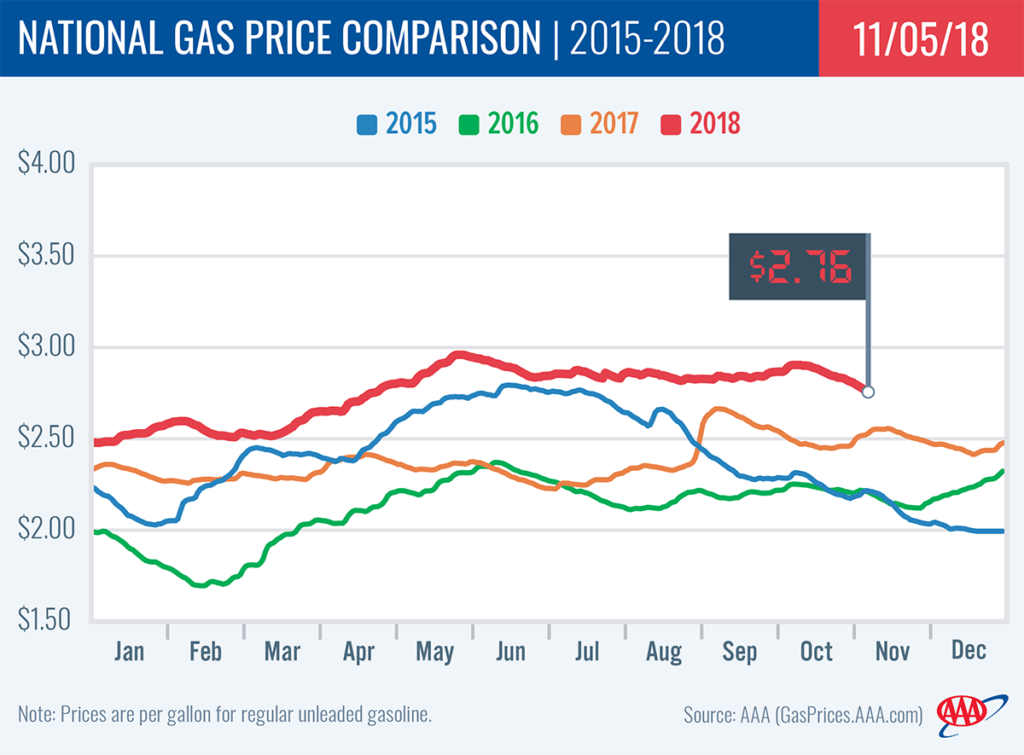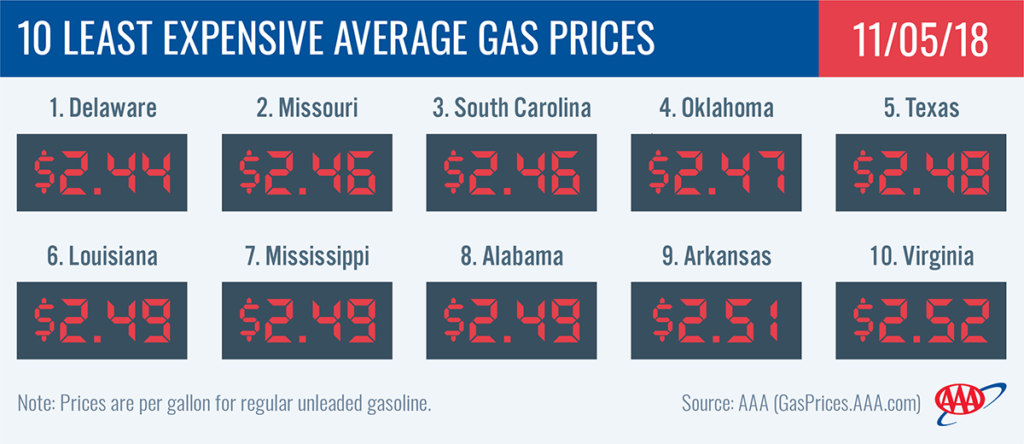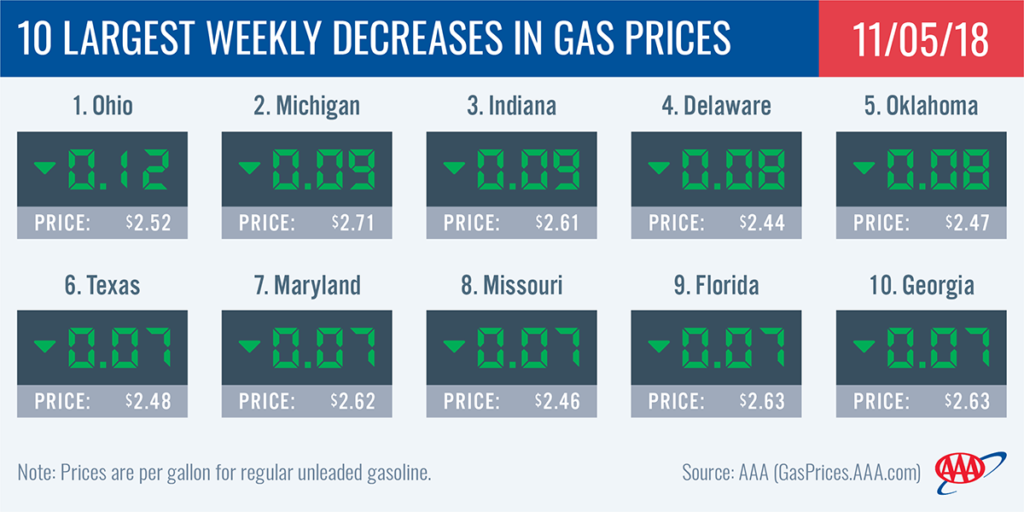At $2.76, the national gas price average is at its cheapest in six months (end of April). On the week, motorists in every state but Hawaii are paying as much as a nickel less to fill-up. Today’s national average is six cents less than a week ago,15-cents less than a month ago but 24-cents more than a year ago. As demand continues to drop, gas prices could get even cheaper.
This price drop is happening at a time that analysts previously thought would likely see pump price increases due to the White House’s re-imposition of sanctions on Iran, some of which will target the country’s energy sector and impedes its ability to export oil. However, in May, when the decision was announced (to take effect in November), the market reacted quickly with crude oil prices (WTI) spiking as high as $77/bbl this summer. At the same time, Iran’s exports began to dip. Today, they are reported to be about one million b/d less than in May while crude oil prices have stayed below $70/bbl for two weeks.
“With the market anticipating and reacting to the pending Iran sanctions throughout the summer, motorists likely have seen the worst in terms of retail prices for the year,” said Jeanette Casselano, AAA spokesperson. “If the crude oil market remains steady, gas prices are likely to continue to fall as much as ten cents in the near-term.”
That being said, should any factors cause an upward shift in crude oil prices, the cheaper gas prices would likely be a temporary trend.
Quick Stats
The nation’s top 10 largest weekly decreases are: Ohio (-12 cents), Michigan (-9 cents), Indiana (-9 cents), Delaware (-8 cents), Oklahoma (-8 cents), Texas (-7 cents), Maryland (-7 cents), Missouri (-7 cents), Florida (-7 cents) and Georgia (-7 cents).
The nation’s top 10 least expensive markets are: Delaware ($2.44), Missouri ($2.46), South Carolina ($2.46), Oklahoma ($2.47), Texas ($2.48), Louisiana ($2.49), Mississippi ($2.49), Alabama ($2.49), Arkansas ($2.51) and Virginia ($2.52).
Great Lakes and Central
Motorists in seven Great Lakes and Central states are seeing some of the country’s largest month-over-month decreases when filling-up at the pump: Ohio (-35 cents), Indiana (-35 cents), Michigan (-32 cents), Kentucky (-28 cents) Iowa (-25 cents), Missouri (-24 cents), and Illinois (-23 cents). The cheaper pump prices come as regional refinery maintenance season begins to wrap-up and are in-line with the national trend. On the week, four states land on the top 10 list of largest changes in the country: Ohio (-12 cents), Michigan (-9 cents), Indiana (-9 cents) and Missouri (-7 cents).
Compared to a year ago only four states in the country have cheaper gas prices and they are all Great Lakes and Central states. Ohio ($2.52) and Indiana ($2.61) are both down 12 cents while Illinois ($2.76) and Michigan ($2.71) are down two cents compared to the same time last year
Regionally, gas prices dropped amid stocks plummeting by 2.5 million bbl to total the lowest level of the year at 47 million bbl, according to Energy Information Administration (EIA) data. Typically, a large draw and low supply levels would push prices higher. However, the region saw lots of volatility in gas prices throughout the summer and early fall, which is continuing.
Mid-Atlantic and Northeast
Motorists across the region are all seeing cheaper prices on the week with Delaware (-8 cents) and Maryland (-7 cents) seeing the largest decreases. Rhode Island saw the smallest change with a two-cent drop since last Monday.
Delaware ($2.44) and Virginia ($2.52) have the cheapest gas price average in the region and land among the lowest state averages in the country. Neither state has seen prices this low since March and mid-April, respectively.
For a second week, the EIA reports that the region saw the largest draw in gasoline stocks in the country. Similar to last week, the draw can be attributed to exports in addition to regional refinery utilization rates falling to 76 percent. Stocks drew by 3.1 million bbl for a total at 64.5 million bbl.
South and Southeast
Nearly half of the country’s top 10 states with the largest weekly decreases are South and Southeast states: Oklahoma (-8 cents), Texas (-7 cents), Florida (-7 cents) and Georgia (-6 cents). As gas prices drop, they are shrinking the year-over-year difference in price. In the region, Georgia and Alabama both have the largest difference of 28 cents more while South Carolina (+22 cents) and Oklahoma (+14 cents) have the smallest difference compared to this time last year. Regardless, South Carolina ($2.46) carries the cheapest gas price average of the South and Southeast states this week.
After four weeks of increases, the EIA reports the region added 2.7 million bbl this past week. Refinery utilization increased slightly to 97 percent and total inventories sit at 80.5 million bbl. The utilization rate is the highest and stock levels are the largest of any region in the country, according to EIA data.
West Coast
Motorists in the West Coast region are paying some of the highest pump prices in the nation, with six of the region’s states landing on the nation’s top 10 most expensive list. Hawaii ($3.91) is the nation’s most expensive market, followed by California ($3.75), Washington ($3.51), Alaska ($3.35), Oregon ($3.34), Nevada ($3.28), and Arizona ($2.90). On the week, all the prices in the region except for Hawaii (+1 cent) are lower. California (-5 cents) saw the largest drop.
The EIA’s weekly petroleum status report for the week ending on October 26, showed West Coast gasoline stocks remained flat at 27 million bbl. Stocks are approximately 600,000 bbl lower than at this time last year, which could cause prices to spike if there is a supply challenge in the region this week.
Rockies
Compared to the rest of the country, gas prices in the Rockies are falling modestly. On the week, Colorado (-4 cents) saw the largest decline followed by Utah, Idaho and Montana, each with a two-cent drop, and Wyoming (-1 cent).
If Utah’s ($3.00) gas price average continues to drop and falls below $3/gal mark, that will be the first time the state’s average has reached this price point since mid-April.
Regional stocks dropped slightly (200,000 bbl) to measure at 6.8 million bbl. Alongside the decrease in stocks, refinery utilization decreased by 4.3 percent to 91.2 percent, which is the second highest rate on the week according to EIA data.
Oil market dynamics
At the close of Friday’s formal trading session on the NYMEX, WTI dropped 55 cents to settle at $63.14. Oil prices moved lower last week as total domestic crude inventories grew by 3.2 million bbl last week, according to the EIA’s latest weekly petroleum status report. Stocks now sit at 426 million bbl, which is 28.9 million bbl lower than the level seen at this time last year, but the highest level since mid-June. Steady growth, for the sixth consecutive week, in crude inventories has helped to check excessive increases in crude prices. Moreover, reimposed sanctions on Iran’s crude exports have not ignited fears in the market about constrained global supply this winter, since the U.S. will reportedly issue eight waivers that allow some of Iran’s top export destinations to continue importing its oil. Oil prices could remain flat or continue falling this week due to reduced concerns about a global crude supply shortage as a result of the sanctions.
Motorists can find current gas prices along their route with the free AAA Mobile app for iPhone, iPad and Android. The app can also be used to map a route, find discounts, book a hotel and access AAA roadside assistance. Learn more at AAA.com/mobile.



